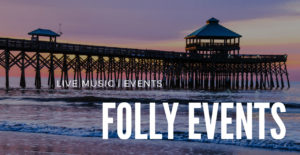2015 has been a great year for sea turtles
By Warren Cobb | Managing Editor
Sea turtles have been visiting Folly Beach to lay eggs for millennia. This evolutionary behavior continues today between the months of May and September. But the cycle is not without its challenges. Instead of natural predators, human beings have become the biggest hindrance to sea turtle reproduction, specifically artificial lighting.
However, 2015 is shaping up to be a big year for Folly’s turtles. Nancy Smith, head of the volunteer organization Folly Beach Turtle Watch, said this is the highest nesting season in 20 years, and it speaks well to the state’s overall sea turtle health. “This is not limited to Folly, its state and region-wide,” she says. Both the number of tracks spotted and number of nests found have nearly quadrupled in number in 2014.
Here is a summary of the year so far:
2015: 181 Tracks; 93 Nests; 15 Hatched; 915 Hatchlings; 9 Strandings.
2014: 46 Tracks; 22 Nests; 22 Hatched; 2,011 Hatchlings; 7 Strandings.
Smith says Folly’s 2014 Beach Renourishment Program had limited impact on nesting patterns. “Beach renouishment has nothing to do with our nesting numbers,” she said. “Our highest ever nesting season was 2013 when we had almost no beach at all. Last year’s low totals were state and regional lows, not limited to Folly.”
Renourishment had two affects on Folly’s sea turtles, Smith says. On the positive side, it created a wider margin of dry sand for nesting. On the downside, the wider, flatter beach created a longer crawl for hatchlings to be exposed to predators and to be disoriented by lighting disturbances. Also, the sand is also much more compacted than a “natural” beach, resulting in abandoned nesting attempts. “The momma turtles attempt to dig in hard, shelly sand and cannot dig deeply enough to deposit their eggs, so they return to the ocean without nesting,” Smith says.
Folly Turtle Watch has about 60 volunteers, a very experienced, dedicated crew Smith says. Volunteers identify tracks and nests, count eggs and relocate them if necessary, and rope off nests to keep people from accidentally disturbing them. These volunteers have a great love and interest in protecting Folly’s sea turtles. “We certainly have a passion for sea turtles,” Smith says. “They’re amazing survivors, and would likely still be doing great if humans would back off a little. Being involved with the nest protection on Folly magnifies the habitat and human challenges that turtles encounter. Turtles have a tough time here.”
Although most beachcombers are well-meaning in their interactions with nests, sometimes it creates a bit of a hindrance instead of help.
“This season, we’ve had field signs around fresh nests disturbed by well-meaning people who saw the turtle nesting,” says Smith. “They attempted to ‘protect’ the nest site by laying a lifeguard stand down in front of it. It’s always best, of course, to just keep a distance and not disturb the turtle or her nesting area in any way.”
In addition to a hands-off approach, Smith says humans can help sea turtles immensely by being sensitive to the havoc that unnatural light can have on nesting turtles and hatchlings, and encourages residents and visitors to practice and preach “Lights out for Turtles!” Brightly lit beaches are a deterrent to nesting females and a deathtrap for hatchlings. Instead of being attracted by the natural light of the moon and starlight on the surf, hatchlings move toward the brighter beams of streetlights, porch and deck lights, floodlights, interior lights, car headlights, flashlights, etc. They fail to find their way to the ocean quickly and become the victims of ghost crabs and gulls, or die from dehydration in the morning sun.
“The biggest problem we’ve had is more people on the beach at night with smart phones taking flash photos and using flashlights,” Smith says. “A dark, empty, quiet beach is best, and Folly is rarely that.”
For more information about sea turtles on Folly Beach, visit www.follyturtles.com. For more information about protecting sea turtles for future generations, visit www.dnr.sc.gov/marine/turtles/nest.htm

